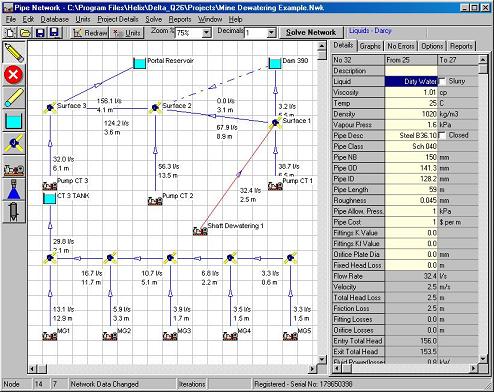Helix delta-Q Pipe Network Analysis Program
From Helix Technologies web site:
delta-Q is a powerful tool for engineers and equipment suppliers to quickly and easily design and optimise pipe networks for compressible and incompressible fluids. You can produce economically and technically sound pipe system designs in a very short time. You can calculate friction losses and pressure drop in pipes and fittings for Liquids, Slurries and Gasses. Model complex process flow pipe networks and solve for unknown flow rates and node pressures at the press of a button. Retrieve data from user accessible databases for Liquids, Slurries, Gasses, Pumps, Pipes and Fittings or add your own data.

Features:
- delta-Q includes a CAD DXF file generator for exporting the network diagram to CAD
- Design and Solve Complex Pipe System Networks.
- Solves for any number of pipes, nodes and pumps. Uses matrix algebra combined with the Newton-Raphson method for quick, accurate convergence.
- Drag and Drop Network components onto the screen for quick and easy network creation.
- Add individual fittings to pipes using the fitting database or enter an estimate of the total K value.
- Calculate Fitting Losses using the standard K value method or the Kf method which compensates for fluid viscosity and turbulence.
- Comprehensive Databases for Pipes, Liquids, Slurries, Gasses and Pumps.
- Setup individual Fluids and properties in each pipe – Model real world process flows with different fluids in the same network.
- Model what if scenarios – close off certain pipes and view the effects on the network.
- Display the Network Calculation Results such as Pipe Flows, Velocity, Head Loss, Node Pressure and many others on the Network Diagram.
- Network Reports Display and Print the Network Pipe and Node Data and Calculation Results in compact Tabular Form.
- Export the Results to Spreadsheets like MS Excel
- Click on a Pipe to View the System Curve with the Network Duty Point shown.
- Perform Complex Orifice Plate Calculations automatically merely by adding an Orifice to a Pipe.
- Include Networks with unknown pressure nodes and unknown flow nodes or any combination of the two.
- Model networks containing any number of pumps, reservoirs and spray nozzles and other components.
- Build a Model to simulate almost any Process Flow condition including pipes, fittings, valves, pumps, orifice plates, vessels, sprinklers, nozzles, columns, flow and pressure control valves.
- Model any number of pipes, junctions, pumps, vessels, sprinklers, nozzles, tanks, intakes, and outlets as you like in one network.
- Add individual fittings to each pipe or enter a global K value or Kf value for a quick estimate of fitting losses.
- You can have different fluids in the same network. For example, you may have a concentrated slurry in one pipe flowing into a junction with a water pipe (or pipes) and dilute slurry flowing through the network from that point onwards.
- Pipe capital vs. operating costs are calculated to assist you to make decisions on the most economical pipe size for an application.
- Use any Engineering units you require – it is easy to add your own units, or select Metric, SI or English units supplied with the program.
- The program is supplied with Sample files and on-line Help to get you started quickly and easily.
For more information see Helix website
i am interesting in desighnig hydraulic network
I am a professor of Mechanical Engineering at Univ of Texas at El Paso. We teach a course intitled Thermal-Fluid Systems Design. I am looking for a pipe network analysis software to be used by the students in this class. Your delta-Q program seems perfect for this purpose. Would you please provide me with a complete description of its capabilities and the cost of the program.
Thanks